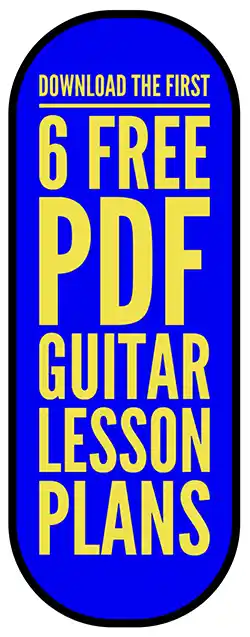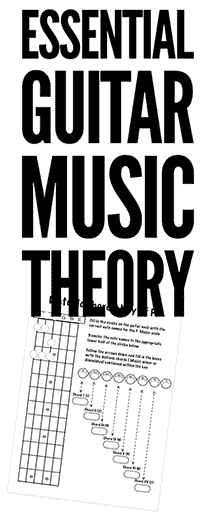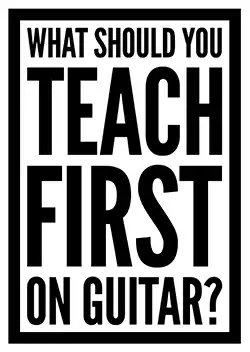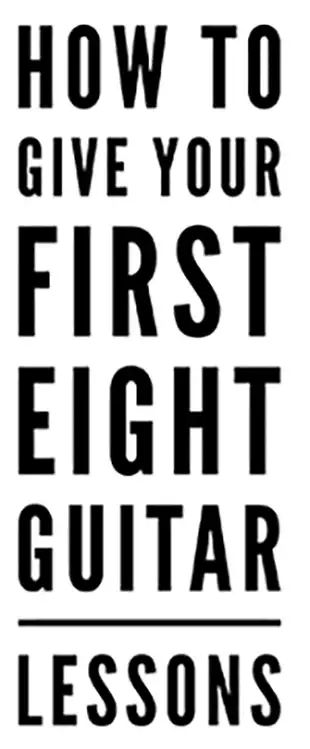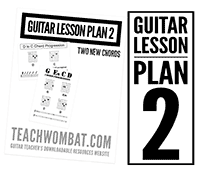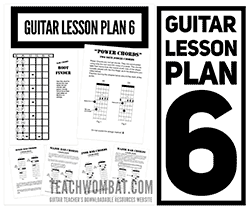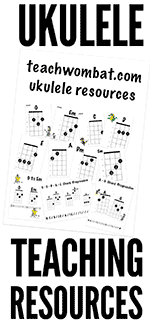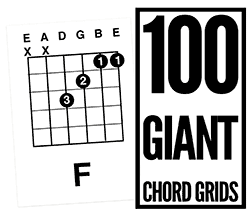
A set of tips, tricks and observations designed to help guitar teachers to function and flourish
This section is presented as a series of short articles and opinion pieces. It contains (I hope!) loads of valuable material that will help you in your guitar teaching career. All of it will not be useful for everybody. If something here is not for you just keep scrolling till you come to a bit that does interest you. Unlike the other pages on this website (such as the entire section dedicated to teaching children to play the guitar or the pages where we look at a series of guitar lessons for the absolute beginner) there is no overriding theme. Its just a bit of the site that I use to unload some of the random stuff that is going around in my head
Guitar Teaching Tips
When setting out to give tips to would be guitar teachers it is important to recognise that “There are many spokes to the centre of the wheel” which is just another way of saying that teaching people to play the guitar is ridden with variables and that no two teachers (or no two guitar students for that matter) are the same
This section of the website will contain a series of short (what I hope are) insights into the inner workings of the brain of a guitar teacher. These tips and tricks are not designed to work for every guitar teacher in every situation. They are just things that (sometimes) work for me and might (sometimes) work for you
Every guitar teacher is different. Every guitar student is on their own journey and therefore every lesson is bound to be at least slightly different. There is another old proverb which states something along the lines of “you can never step into the same river twice” and even though at the beginning of a lesson we might make assumptions about the likely behaviours and capabilities of our students we need to be able to adapt in accordance with the actual circumstances rather than just throw the same bunch of “stock” lessons in the same order at all of our learners
Some guitar students will pick up particular concepts and techniques remarkably quickly but might struggle with technical or theoretical areas that we could initially predict that they would take in their stride
Whilst you need to have a plan for your guitar lesson it is important to be able to adapt (or even abandon) it should the occasion demand or the opportunity present itself You may find that a student needs to go back over some old ground that you thought they were comfortable with or it could be that you discover that they are more competent with regard to theoretical knowledge or technical ability than you expected at the start of the session
The list of potential variables that exist at the beginning of any guitar lesson means that it is almost inevitable that the experience that you deliver to your guitar student will not be quite the same as the one that you thought that you would be providing at the start of the session? If a guitar teacher expects this and has a range of resources and strategies designed to accomodate this reality then they should be able to take this variety in their stride
The “Best” Guitar Teaching Tip
Perhaps the most important tip that I can offer to someone setting out to be a guitar teacher is to say that the single principle underpinning the whole subject of guitar teaching and perhaps the key to teaching guitar for a living is to work out the answer to the question “what is the best thing you can do for this person’s guitar playing within the next hour”?
Guitar Teaching Tips: Tablature
Guitar Tablature is Evil!
It does not tell you what note you are playing. It does not give you any clue as to how your melodic input is affecting the harmony of the music. It does not tell you the scale or mode that you are using over the chord sequence. It does not tell you when to play so you need to be familiar with the song, riff or solo that you are trying to reproduce (in which case what’s wrong with using your ears to work it out)
Pretty much all tab does tell you is where someone in a recording studio somewhere once pressed their fingers onto a guitar neck Guitar tablature tricks people into believing that they are much better guitar players than they actually are
When the Pope (maybe a couple of popes ago) used to land in a country where he didn’t live he would endear himself to the faithful by saying a couple of phrases in the language of that country. At no point did he claim to understand the language and everyone knew that it was nothing more than a gesture. He had learned the phrases “parrot fashion” purely for effect
Thats ok for him (after all he may have had friends in high places) but it’s no way to be as a guitarist
Knowing where to put your fingers without knowing why you put them there is maybe not the best way to go about things? Everone and their pet monkey can play the intro to Sweet Child O Mine but how many of them can explain how it works harmonically and melodically?
Guitar Tablature is like Guns!
Alright I admit it. I’m overstating the case a little bit. In fact this website is trying to sell you a set of resources in which blank guitar necks and tablature sheets play an important part but I suppose the point I’m trying to make is that guitar tab should be used to assist and reinforce knowledge and understanding rather than to sidestep or replace it? Guitar tablature is like Guns... Perfectly safe and sensible if used by the right people in the right way but the potential for disaster if used wrongly does not bear thinking about

Guitar Teaching Tips: Patience
Teaching guitar Requires No Patience at all!
Teaching Guitar requires no patience Learning to play the guitar takes a little patience but teaching it requres only understanding. Understanding and patience are two completely different things
I have (almost) no patience (you can ask my wife). I will not even queue for beer and I like beer (again, you can ask my wife). If we decide that we need a new sofa I refuse to entertain the notion that the bloke in the furniture shop has to drum up a special order from a factory on the other side of the planet and that once nailed together my stuff must be loaded onto a ship and dragged halfway around the globe before I can sit on it and drink a beer (did I mention that I like beer?). I want the one in the window and I want it to be delivered tomorrow and If I can’t have it I’ll go to the shop next door and buy a different one
Patience, in my book is in no way a virtue, it’s a way of justifying inactivity. So how come I get to make my living teaching people to play the guitar, an activity that most people think requires industrial quantities of patience?
Let’s take a closer look at this whole patience thing..... It is understandable (and desirable) for a guitar player to be impatient to get better. It is a disaster if the teacher shares this impatience
If you spend an entire lesson willing your student to be able to play the thing that you have just shown to them then you (and they) will achieve nothing. Looking at another person’s fingers while they try to play music that is (at the moment) beyond them and investing any great emotion into it will hurl you headlong into an early grave
Staring bug eyed at someone elses hands trying to do things that they are not capable of doing because they have not yet had the time to work on it will lead to you to a life of wearing odd socks, weeping uncontrollably and shouting at traffic!
Allright, maybe I’m laying it on with a trowel here but you get the picture The point of a guitar lesson is not that the student goes away from it able to play something that they could not when they walked into the room an hour earlier. The objective is that they go away with something to practice which will mean that they are better when they next walk into the room. Understand that and you will see that (for the teacher anyway) patience plays no part in the process
If students find everything that you show them easy don’t kid youself that it’s because you are a fantastic guitar teacher. Your guitar teaching most probably (to use the modern vernacular) sucks Why should somebody pay you to show them things that they can just about do already (they already have tribes of internet tab monkeys for that)?
If however, at the end of a lesson with you they go away with a few things to work on that they understand and can almost play then you are doing it right. If they then return able to play those things then they are doing it right (remember that teaching is about learning and that the most important role in the process is that of the learner and not that of the teacher)
The job of teaching guitar is largely about three things....
1. Developing Technical Ability
2. Helping the student to develop a workable theoretical framework
3. Developing Repertoire
If you spend an hour paying attention to those three areas you won’t need to watch your students practicing (I love teaching guitar but I refuse to waste my life and other peoples money watching someone practice it – once they understand what they need to practice by themselves it’s time to move on with the lesson)
Our guitar students do not pay us for our patience, they pay us for a plan. I’m off to lie down on my sofa (possibly via the fridge?)
Guitar Teaching Tips: When to introduce Music Theory
Don’t introduce music theory to your guitar students too early
Music theory is very important but to focus on it in the early stages of teaching guitar to a complete beginner is not neccesarily the best way to help someone to become able to play the instrument
In the early stages of study aspiring guitar players need to be encouraged by developing their physical and technical abilities rather than be discouraged because they are introduced to a body of knowledge that (if we as guitar teachers are not careful) can appear to be so complicated that it may even put them off playing
Music theory is not complicated and your students should study it but not neccesarily within the first few months of a their “journey”. They need to first feel that they are becoming guitar players. Imagine the frustration that they will experience if after a few months spent developing an understanding of the “nuts and bolts” of music theory as it applies to a guitar player (scale and chord construction?) to suddenly realise that they are not really a great deal closer to making a noise like a musician than they were when they first came to you for guitar lessons? Such a realisation will most likely lead to one of two results
1: They will become discouraged and give up playing the guitar?
2: They will find a guitar teacher who makes them feel that they are making progress
For obvious reasons neither of the two options presented above are what we are looking for either as effective educators or as people who put bread on the table using money that we earn by helping people to become guitarists
We should develop an awareness of just when aquiring a knowledge of music theory will become a tool that our guitar students can use rather than a hurdle that they have to get over and that point is (for me) when they have developed the dexterity to play and change between the eight chords in the basic CAGED System
The chords (C A Am G E Em D and Dm) represent the easiest shapes for a novice guitarist to learn and mastering the ability to change between them using a few basic strumming patterns will just about put a guitar student in the place where he or she can derive benefit from knowing how it works (rather than just that it works)
At around about this stage (during a small section of each lesson – we are still spending most of each session continuing to develop physical skills) I introduce the concept of intervals of a whole and a half step on the guitar. I then go on to use these intervals to construct a scale of C major (naming the notes as we go)
When my students undestand this we look at using the first, third and fifth notes of the C Major scale to construct a C Major chord. Following on from there we look at constructing a couple of other major scales and chords (G and D since you ask?) using the same series of intervals. Next up its minor scale and minor chord construction and the differences (the flattened third) and similarities (the root and the fifth) between the two chord types.
From this point it is to be hoped and expected that the world of music theory as it applies to guitar hopefully does not seem so scary to a novice player
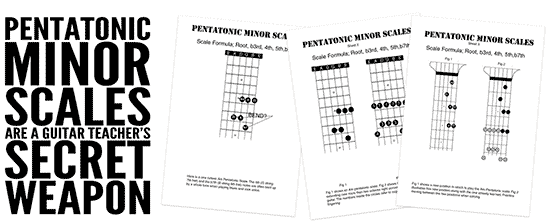
Guitar Teaching Tips: The Pentatonic minor scale
The pentatonic minor scale is one of the best friends that a guitar teacher can have
For Guitar Teachers the Pentatonic Minor Scale is one of our “bread and butter” resources It is perhaps the scale that we can most easily use to introduce the concepts and principles of improvisation (particularly in rock/blues styles) on the guitar as it contains notes that lend themselves readily to techniques such as string bending and vibrato etc.
The minor pentatonic scale is in some ways a little bit dangerous because it sounds so (maybe even too?) good once beginners start to develop a bit of a facility with it Many (even quite experienced) guitar players can sound pretty professional in some circumstances without much more than the ability to wander around the scale and bend a few notes here and there
That said the use of the minor pentatonic is a great way to help our guitar students believe that they are capable of developing the facility to solo and improvise on the instrument
The scale formulae for the pentatonic minor scale is as follows
Root-b3-4-5-b7
Of those note the 4th and the b7th are particularly suited to being “bent” The guitar fretboard diagram (above to the right) is taken from one of our guitar teacher’s printable handouts and shows the minor pentatonic scale formulae along with information relating to which notes can be “good to bend” in a blues or rock situation? Below you can also see some other guitar teacher’s student handouts relating to the minor pentatonic scale. They show the A minor pentatonic scale extended to cover several areas of the guitar fretboard

HOW TO DOWNLOAD
the Guitar and bass teacher's Toolkits
Buy your teachwombat.com toolkits in complete safety via any major credit card (through paypal) or directly through your paypal account if you have one. If you choose to use a credit card, rest assured that we never see your credit card details as paypal do all of that for us.
When Paypal receive your payment you will be immediately invited to click a
"RETURN TO MERCHANT"button.
You will be taken to a page from where you can download the products that you have paid for NOW!
In the (rare) event that something should go wrong with the order/download process just email me at robh@teachwombat.com
I will check the order and send you the links that will get you to your stuff.
Cheers! Rob!
The Deluxe Package:
Download all of our products for just $25.00
Guitar and bass teacher's toolkit (with business cards and diary/accounts pages) backing tracks and handouts- and giant guitar grids
the package consists of...........
The Backing Tracks and Handouts Package
20 Backing Tracks and 46 Handouts. An invaluable aid designed to help you to teach both rhythm and lead guitar." If they can't play in time then they can't play?"
The Guitar Teacher's Toolkit
100 printable sheets covering Open Chords-Bar Chords-Scales- Modes- Blank Fretboard and Chord Grids Teaching Diary and Business Card DesignsThe Bass Teacher's Toolkit
Over 60 Handouts covering Scales, Chords, Fingering Exercises etcPlus 100 Giant (letter sized) Chord Grids
laminate them in order to help you to teach group guitar lessons, distribute them to your students or just stick on your teaching studio wall? The "Coolest Wallpaper on the planet?" Over 300 Sheets to Download and use TODAY!
Everything you need to start or improve a guitar teaching business! It's all there!
Only $25.00 (a saving of $16.00)
Bass Teacher's Toolkit only $10.00
More than 60 Sheets dealing with scales- Chords- Fingering Exercises and Blank Fretboard Diagrams (for both four and five string instruments)
They take care of the payment side and you can be sure that we never get to see your credit card details
Click The PayPal logo above to purchase and download the guitar teacher's toolkits NOW


